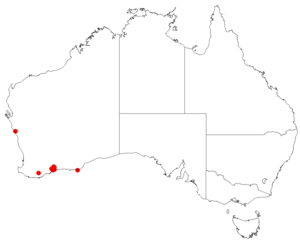Leucopogon compactus
| Leucopogon compactus | |
|---|---|
| Scientific classification | |
| Kingdom: | Plantae |
| Clade: | Tracheophytes |
| Clade: | Angiosperms |
| Clade: | Eudicots |
| Clade: | Asterids |
| Order: | Ericales |
| Family: | Ericaceae |
| Genus: | Leucopogon |
| Species: | L. compactus
|
| Binomial name | |
| Leucopogon compactus | |

| |
| Occurrence data from AVH | |
| Synonyms[1] | |
Leucopogon compactus is a species of flowering plant in the heath family Ericaceae and is endemic to the south of Western Australia. It is an erect, much-branched shrub that typically grows to a height of 0.3–1 m (1 ft 0 in – 3 ft 3 in). Its leaves and branches are covered with grey, shaggy hairs, the leaves are oblong and mostly less than 12 mm (0.47 in) long. The flowers are white and arranged in dense clusters on the ends of branches and in upper leaf axils. The sepals are about 2.5 mm (0.098 in) long and, with the bracts, are covered with long hairs. The petals are about 4 mm (0.16 in) long and the lobes are longer than the petal tube. Flowering occurs from June to August or December.[2][3]
This species was first formally described in 1859 by Sergei Sergeyevich Sheglejev in the Bulletin de la Société impériale des naturalistes de Moscou.[4][5] The specific epithet (compactus) means "compact" or "united".[6]
Leucopogon compactus grows on plains and hillslopes in the Esperance Plains bioregion of southern Western Australia and is listed as "Priority Four" by the Government of Western Australia Department of Biodiversity, Conservation and Attractions,[2] meaning that it is rare or near threatened.[7]
References
- ^ a b "Leucopogon compactus". Australian Plant Census. Retrieved 11 July 2022.
- ^ a b "Leucopogon compactus". FloraBase. Western Australian Government Department of Biodiversity, Conservation and Attractions.
- ^ Bentham, George; von Mueller, Ferdinand (1868). Flora Australiensis. Vol. 4. London: Lovell Reeve & Co. p. 192. Retrieved 11 July 2022.
- ^ "Leucopogon compactus". APNI. Retrieved 11 July 2022.
- ^ Sheglejev, Sergei Sergeyevich (1859). "Epacridearum Novarum". Bulletin de la Société impériale des naturalistes de Moscou. 32 (1): 13. Retrieved 11 July 2022.
- ^ Sharr, Francis Aubi; George, Alex (2019). Western Australian Plant Names and Their Meanings (3rd ed.). Kardinya, WA: Four Gables Press. p. 167. ISBN 9780958034180.
- ^ "Conservation codes for Western Australian Flora and Fauna" (PDF). Government of Western Australia Department of Parks and Wildlife. Retrieved 11 July 2022.
Error: "Q17241361" is not a valid Wikidata entity ID.
- FloraBase ID not in Wikidata
- Articles with short description
- Use Australian English from July 2022
- All Wikipedia articles written in Australian English
- Use dmy dates from July 2022
- Articles with 'species' microformats
- Taxonbars desynced from Wikidata
- Taxonbar pages requiring a Wikidata item
- Taxonbars with invalid from parameters
- Taxonbars without secondary Wikidata taxon IDs
- Leucopogon
- Ericales of Australia
- Flora of Western Australia
- Plants described in 1859
- All stub articles
- Ericaceae stubs
- Australian asterid stubs
